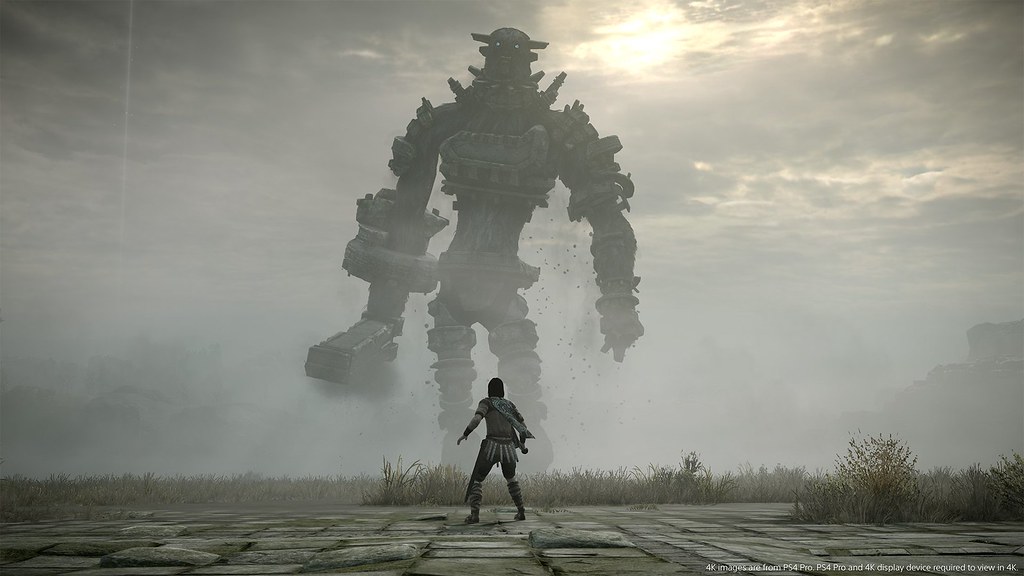During the Easter break I had time to engage with a few games that I hadn’t played for a long time. Since, I also used Shadow of the Colossus recently for a lecture on theories and principles on video game animation, I was glad to replay the game. Furthermore, I feel that it makes sense to document games that I will be using for classes and lectures in the future to provide a resource of games that are worth looking at for academics and educators and point out from which research angles it makes sense to look at the game . Moreover, I will take this opportunity to experiment with ChatGPT for co-authoring articles. Base texts and descriptions will be written by ChatGPT and then edited by me. Any other form of content that exceeds formal descriptions will be written by me (i.e., criticism, opinions, commentary, conclusions, interpretations, analysis).
Shadow of the Colossus is a video game that has been hailed as a masterpiece of the medium since its release in 2005. Developed by Team Ico and directed by Fumito Ueda, the game is known for its beautiful and desolate world, its minimalist storytelling, and its epic battles against towering colossi. Here I will be referring to the remake from 2018 by Bluepoint Games (who have also done the marvellous Demon’s Souls remake).
The player takes on the role of Wander, a young man who has come to this forbidden land in order to resurrect a girl named Mono. To do this, he must slay 16 colossi, who are the guardians of the land. These colossi are not simply obstacles to be overcome, but rather representations of the natural world itself. They are massive creatures, made of stone, fur, and scales, and each one is unique in its appearance and behavior. In order to defeat them, Wander must climb onto their backs and find their weak points, using his sword and bow to strike them. Once a colossus is defeated, the game loop repeats. Being told which colossus to defeat, traversing the game’s world to find the colossus and then defeating them.
One of the most striking aspects of Shadow of the Colossus is its world. The game takes place in a vast and empty landscape, filled with ruins, forests, and canyons. There are no other human characters in the game to interact with, no NPCs to talk to or quests to complete. The player is alone in this world, except for the colossi, which serve as the game’s bosses. This sense of isolation and emptiness is intentional, and serves to reinforce the themes of the game. Yet, the game does not fall victim to an empty and ‘boring’ world since traversal through the game’s geography with one’s horse Agro feels great. The controls and their animations are very responsive, and the horse’s movements are fluid and natural. This makes riding a joy, whether you’re galloping through a field or carefully making your way up a steep mountain trail. As mentioned earlier, the game’s world is vast and open, and riding allows you to explore it at your own pace. There are no fixed paths or predetermined routes to follow, so you can ride wherever you want and take in the scenery as you go.
The gameplay mechanics of Shadow of the Colossus are simple. The player controls Wander from a third-person perspective, and must navigate the world, find the colossi, and defeat them. However, the real challenge of the game comes from the colossi themselves. Each one presents a unique puzzle that the player must solve in order to find its weak points. Some colossi require the player to climb up their legs, while others require the player to shoot them with arrows in order to make them vulnerable. This variety keeps the game fresh and engaging throughout its 16-hour runtime.
In conclusion, Shadow of the Colossus is a remarkable game that deserves its reputation as a masterpiece. Its beautiful world, minimalist storytelling, and epic battles against colossi combine to create a unique and powerful experience that is unlike anything else in the medium. The game’s themes of man vs. nature, sacrifice, and mortality are explored in a thoughtful and nuanced way, and the gameplay mechanics are both engaging and challenging. Shadow of the Colossus is a must-play for anyone interested in video games as an art form.
Furthermore, I recommend Shadow of the Colossus for researchers and students interested in environmental storytelling, animation and game loops. The game provides surely more to discover. At any rate, Shadow of the Colossus is considered a masterpiece and classic for a reason and any person that inspires to become an expert in video games should have at least played one chapter of the game.
Full Playthrough:
Further Sources:
Fortugno, N. (2009). Losing your grip: Futility and dramatic necessity in Shadow of the Colossus. Well played, 1, 171-186.
Gibbons, W. (2014). Wandering tonalities: Silence, sound, and morality in Shadow of the Colossus. In Music in Video Games (pp. 136-151). Routledge.
Lehner, A. (2017). Videogames as Cultural Ecology: Flower and Shadow of the Colossus//Videojuegos como ecología cultural: Flower y Shadow of the Colossus. Ecozon@: European Journal of Literature, Culture and Environment, 8(2), 56-71.

